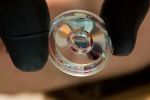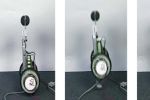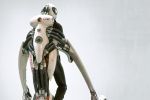How It Works: Tomorrow's Hybrid
The ReCharge, Volvo’s concept plug-in hybrid, could squeeze 160 miles from a gallon of gas by tossing out the power-wasting transmission. It packs a small electric motor inside each wheel, so that no power is lost in the drivetrain. Here’s a look at the next generation of fuel-efficiency
How Wheel Motors Drive the Car
Putting electric motors directly inside the wheels eliminates the transmission, which typically wastes 10 to 20 percent of the engine’s energy. An interior disc, mounted to the wheel bearings, contains a series of independently controlled electromagnets, which emit a magnetic field in response to an electrical current. Around that, an outer ring contains permanent magnets. Step on the accelerator, and a computer in the interior ring begins to rapidly switch the polarity of the electromagnets, repelling or attracting the permanent magnets. The faster the polarity changes, the faster the motor spins the wheels.
The challenge is controlling four independent motors—if one spins even slightly faster, the car could veer violently. The ReCharge team’s next big hurdle is refining the software that maintains precise control. As for performance, the car will have permanent all-wheel drive with no gearbox standing between your foot and the motors—in other words, it should go like a rocket.
Batteries power all four motors and the car’s electronics. Unlike most plug-in hybrids, the ReCharge uses a lithium-polymer (rather than lithium-ion) battery. This is not only safer—it uses sheets of plastic instead of a volatile electrolyte solution—but it also powers the car for 60 miles before the engine kicks in to recharge it. Small lithium-polymer batteries have started to show up in gadgets such as the iPhone, but Volvo gets its larger, experimental versions from an undisclosed manufacturer.
The engine charges the battery when the car isn’t plugged in. The concept design calls for either a 1.6-liter flex-fuel or turbodiesel engine, but since the engine doesn’t have to actually spin a drive shaft, a fuel cell or a second battery could do the job just as well. It would kick in to recharge the battery only after the battery was at 30 percent capacity, so the ReCharge could travel 160 miles on a single gallon of gas.
A charger feeds power to the battery when the car is plugged in at home. Eventually, the ReCharge will be equipped with an intelligent version that can automatically sense strain in your area’s electrical grid and either cut back its power consumption or feed electricity from its battery back into the system.
Tires must be as thin as possible since the motor makes each wheel bigger.The ReCharge uses specially designed Michelin tires with a soft, resilient surface that also reduces rolling resistance.
More How It Works:
- The toy dinosaur that thinks for itself
- A lightweight, fuel-sipping jet engine
- A pill camera that shoots movies of your gut
- An HD camcorder that steadies shaky hands
- A laser cannon that melts tanks from the air
- An earbud with a subwoofer inside
- Flash memory that can take a dropkick
- A satellite that can photograph home plate from 425 miles up
23 Comments
Popular Tags
Cars
Regular Features

Featured
Cars
How It Works: Tomorrow's Hybrid
A plug-in concept from Volvo brings the power inside the wheels for increased efficiency and extra mileageBlasts From the Past at the New York Auto Show
At this year's NYIAS, nostalgia is king. Launch our gallery to see why
Popular on Popsci
Most Viewed
Cars
- It's Electric: Chrysler Reveals Alternative-Energy Prototypes
- High Compression: Running a Porsche on Air
- Report: Honda to Launch Hybrid Motorcycle by 2011
- Chrysler Reveals Alternative-Energy Prototypes
- A $40,000 Hyundai? Luxuriating in the 2009 Genesis Sedan
- Test Drive: 2009 BMW M6
- The 2009 Hyundai Genesis
Most Commented
Cars
- Report: Honda to Launch Hybrid Motorcycle by 2011
- High Compression: Running a Porsche on Air
- Test Drive: 2009 BMW M6
- Chrysler Reveals Alternative-Energy Prototypes
- It's Electric: Chrysler Reveals Alternative-Energy Prototypes
- A $40,000 Hyundai? Luxuriating in the 2009 Genesis Sedan
- The 2009 Hyundai Genesis
Most Emailed
Cars
- High Compression: Running a Porsche on Air
- Report: Honda to Launch Hybrid Motorcycle by 2011
- Test Drive: 2009 BMW M6
- Chrysler Reveals Alternative-Energy Prototypes
- It's Electric: Chrysler Reveals Alternative-Energy Prototypes
- A $40,000 Hyundai? Luxuriating in the 2009 Genesis Sedan
- The 2009 Hyundai Genesis









Comments
Great Idea! Wasn't this same idea on the cover about 20 years ago?
0 out of 3 people found this comment helpfulIt seems to me that adding the motor drive mass to the wheel will result in a rougher ride. Is this so?
5 out of 6 people found this comment helpfulWait...So you are going to charge the battery with a battery??
Seems to me that if thats the case you should just get a bigger battery! (If you are going to have the space taken up by the extra anyway)
3 out of 6 people found this comment helpfulIts great that Volvo is finally getting around to the innovative designs needed to bring fuel efficiency into the 21st century. I've been refining a similiar concept over the last 3 years, which should result in a 300 mpg efficiency.
I like that their concept will eliminate the Transmission and reduce wasted energy. With a few additional improvements, they should also be able to reduce or eliminate the brakes and use the Electro-magnet as both a motor powering all four wheels and as a power generator which could be used during braking and simultaneously re-charge the battery. Battery size/weight could also be dramatically reduced.
I hope they can bring to market sooner.
Great job guys, keep up the innovative approach.
At your service
Sincerely,
John Frei
12 out of 13 people found this comment helpfulToms River, NJ
Love this design!
1 out of 4 people found this comment helpfulWhat about just having one motor ...in the middle of a solid drive shaft though? It would be simpler, less expensive and wouldn't require 'thin tires'.
Also, if it were put on the rear axle...even simpler!
Connect a solid rear and solid front axle...'twin-axle' drive.
from Wonthaggi, ACT
Not all batteries are the same. They have different characteristics in regards to the amount of power than can be drawn from them, how fast that power can be drawn out, how long the take to recharge, etc. It could easily make sense to have two or more banks of batteries, with different characteristics, one for powering the motors and another for holding large charges on a long term basis.
Myk
1 out of 2 people found this comment helpful-----
Part of the inhumanity of the computer is that, once it is competently programmed and working smoothly, it is completely honest. - Isaac Asimov, 1920 - 1992
Volvo should be acknowledged for reviving some work done by the engineer R.G. LeTourneau. LeTourneau invented Electric Wheel Drive in 1950 for use in heavy equipment, earthmovers and the like. My father was an operating engineer in the 1950s, 1960s, and 1970s, and had occasion to use LeTourneau heavy equipment many times; he noted that operating the electric wheel driven equipment was very much easier than some of the other heavy equipment of the day.
Few folks realize, too, that the hybrid power system is not new. Every modern locomotive is a hybrid. Those massive diesel engines are there to drive generators to power the engines electric drive system. I find it refreshing that these old tried and true approaches, half centuries old, are beginning to be acknowledge for their versatility and economy. My only lament is that the automotive industry has taken so long to move out of their comfort zone and look at true innovation.
4 out of 5 people found this comment helpfulI've heard that heavier tires would be less efficient, and the suppression of a heavier bounce might be the reason.
The artical wasn't clear, on how the standard transmission was a cost of 10-20% of energy. Does that mean the energy soaked up by accelerating the extra mass, or the energy lost to internal frictions? An Electric Transmission will still have the burdens of Power Capacity, where an increase of force or torque will increase the diameter of the axle or conductor.
The problem of ballancing the motors sounds to be what Differentials are for, and those Permanent Magnets are going to demand some kind of virtual commutator. Nikolai, from what I understand, eventually worked out a simple three phase motor, using no commutator, by replacing those Permanent Magnets with Feromagnetism. Think of them as Dynamically Defined Permanent Magnets.
Trolley Busses are known for good hill-climbing acceleration, as well as regenerative breaking, but Turbines are known to have good characteristics in a narrow power band, so the rear wheels might kick the ground, electrically, but also drive the turbine for the front wheels, to eat the ground ahead, when running at speed. Rear Wheels for Acceleration, and Front Wheels to Stop and (really-really) Go.
Arawn
Do you hear what I hear, then you might be selling flowers too.
1 out of 2 people found this comment helpfulI have subscribed to this mag. for 20 years and I think this is the end. As long as the auto companies and big oil can continue the "see no evil, hear no evil and speak no evil", we will continue to be tied to petroleum.
Bugs to produce gasoline? Right, just partner with a oil producer and you will end up like ECD (Energy Conversion Devices) and bury the licenses and patents until they fossilize.
Ethanol? Why is it so hard to use switchgrass, instead of corn? My cornflakes have gone up. Venezuela has had it for years and in different blends, so they can sell us their crude, bad Commies.
Remember the EV1? All of them are crushed and landfill fodder, except for museum pieces that were disabled. How environmental of them.Couldn't own one if you wanted to. Ford was no different with the Electric Ranger. Only leased and had to return without a chance to purchase.
Now, our future is Hydrogen. Forget electric. Congress has spoken, we just play like the little monkeys, too. We haven't reached the point where our thirst for gasoline has destroyed our economy. We can't wait until 2015. Mister President, Mister Speaker of the House, Oil is the Everyman's Heroin. We're ALL addicted. We need DEA enforcement, now. On counseling or 12 step program can help us.We are beyond peak world production, not good till the last drop.
This publication has as much fantacy as it does fact, any more. I do not wish to gamble on my or anyone's future with your silly stock markets. I do hear-by wish to cancel my subscription. By the way, you owe me money with which I might purchase a gallon or 2 of sweet nectar from the gods of babylon.
Keith Missinne
3 out of 4 people found this comment helpfulcheck the subscriber list in one hour. I can't believe I had to join and log in just to clear my throat.
4000 pound vehicle to transport 150 to 400 pounds of people? Does that make good sense? Think we have to rethink concept?
2 out of 3 people found this comment helpful